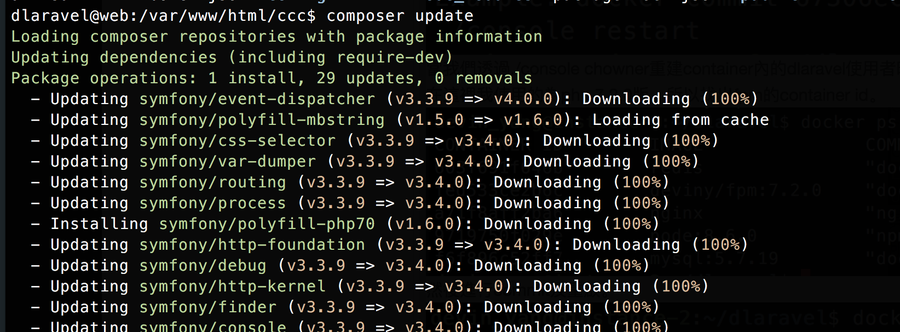foreword
There are still some precautions you should know about the change of Image on Linux.
If you install D-Laravel on a Linux system through docker like me, when you change a different image,
Perhaps you may encounter, doubt! Why composer does not have permission to write to the folder error.
directory is not writable
illustrate
It is very likely that it is different from the user uid and gid executed on your Linux, you can enter the id to check.
If the user uid and gid on your Linux are exactly 1000, basically there will be no problem in executing D-Laravel.

But when your situation is the same as mine, uid and gid are not 1000, which will cause your users on Linux to execute composer,
If you do not have permission to write to the home directory of dlaravel, when you enter composer update,
You will see the following error: OK, this is normal, don't be too alarmed.

The correction method is very simple. To put it bluntly, just change the uid and gid of dlaravel to be the same as the uid and gid of the Linux user you are running.
If you are not familiar with Linux instructions or Docker, or if you are quite familiar with Linux instructions, it is just a lazy adjustment.
The goal of D-Laravel development is to let people who don't understand Docker or who understand Docker can use the simplest way to get the environment,
Of course, D-Laravel has provided converted bash.
D-Laravel's correction method:
./console chowner method provided by D-Laravel to easily adjust.How to identify
./console chowner ? Then execute the user id and gid of
./console chowner ,Create the same dlaravel user in the container, and then change the permissions of the dlaravel home directory.
Crude enough, but it works.

The latest version of D-Laravel no longer uses this brutal method to change the user's uid and gid, and there is a better way.
https://www.ccc.tc/article/dlaravel-release-v1.5.5
When we rebuilt the dlaravel user in the container through
./console chowner ,We need to write the changes and write data to the image of deivny/fpm used ,
Due to the docker-compose environment, the container will be removed when down is executed.
So we have to save the container changes into the image template,
In this way, the execution container will be the environment we changed when the next startup occurs.
In this example, I am using version 7.2.0 of php, so find out the CONTAINER ID of fpm.

Then commit and restart.

After completion, enter the container, and then run to see
composer update .You can see that after changing the permission, it can be updated normally, and composer will no longer complain about not having permission to write to the added directory.

If you have any questions about the use of D-Laravel, please leave a message in the chat room.




No Comment
Post your comment